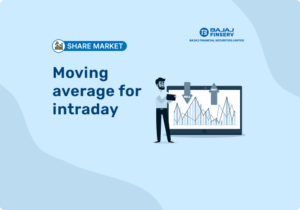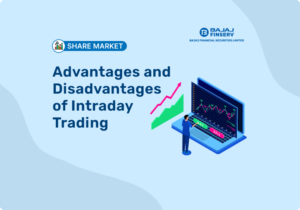EMA for Intraday
Last Updated on January 31, 2024 by ethinos

When you’re trading stocks and need to make quick and smart choices, using the right tools can have a big impact. The Exponential Moving Average (EMA) strategy is one such tool that can really help you with your intraday trading efforts. An exponential moving average (EMA) is a common tool on charts that shows how the price of securities like stocks changes over a specific time. Unlike the simple moving average (SMA), the EMA pays more attention to recent data, like the latest prices. That’s why it reacts faster to changes in prices compared to the simple moving average.
In this blog, we’ll unravel what EMA in stocks is, how it operates, and how you can use it to your advantage.
Table of Content [hide]
- 1 Understanding the EMA Strategy
- 2 What is EMA in Stocks?
- 3 What Time Period is Best for Calculating EMA?
- 4 Calculating Exponential Moving Average (EMA)
- 5 How Does the EMA Indicator Work?
- 6 When to Leverage Exponential Moving Average
- 7 Trading Rules or General Steps to Use Best EMA Strategy for Intraday
- 8 Differences between Exponential Moving Average (EMA) and Simple Moving Average (SMA)
- 9 Advantages and Disadvantages of Exponential Moving Average (EMA)
- 10 Conclusion
Understanding the EMA Strategy
Imagine you’re navigating through a maze of stock market data, seeking patterns, and trends. The EMA trading strategy is your map and compass in this intricate landscape. The Exponential Moving Average is a technical tool that traders employ to dissect stock price trends over specific periods. It’s not just another line on a graph; it helps you pinpoint potential opportunities in the market that you can act upon.
What is EMA in Stocks?
EMA takes the raw data of price fluctuations of a stock and reveals the underlying trend and pattern. In other words, it’s like a translator that transforms the stock’s price history into an understandable language, allowing you to make sense of its journey.
What Time Period is Best for Calculating EMA?
Now, let’s talk about the best EMA for intraday trading. Imagine EMA as a camera lens focusing on different aspects of the market. For intraday trading, the lens needs to be sharper. This means shorter timeframes, like 5-minute or 15-minute intervals, are preferred. They capture the quick rise and fall of prices within a single trading day. However, if you’re a swing trader, exploring longer timeframes like 1-hour or 4-hour intervals might suit your style.
Calculating Exponential Moving Average (EMA)
Calculating EMA is simpler than it sounds. Here’s how you can figure out EMA in trading
- Choose a time period (e.g., 15 minutes).
- Calculate the Simple Moving Average (SMA) for that timeframe.
- Determine the smoothing factor (usually a number close to 2 / (time period + 1)).
- Crunch the numbers for the EMA using this formula:
EMA = (C – P) * K + P
C = Current Price
P = Previous EMA
K = Smoothing Factor
The Smoothing Factor ‘K’ gives more importance to the latest price. It takes into account the number of periods you’ve chosen for the moving average.
How Does the EMA Indicator Work?
The EMA indicator acts like a spotlight, emphasising the recent scenes while softly fading out the older ones. This dynamic spotlight helps you quickly spot shifts in the narrative. When the stock’s price crosses above the EMA, it’s like a signal that the story might be taking a positive turn. Conversely, a crossing below might signify a twist in the plot.
When to Leverage Exponential Moving Average
EMA trading is your go-to strategy when you’re aiming for short-term intraday gains. Its agility in picking up rapid changes in price direction is particularly suited for intraday traders.
Trading Rules or General Steps to Use Best EMA Strategy for Intraday
Here’s a general roadmap to get you started on the right foot:
- Choose Your Timeframe: Pick a timeframe that aligns with your trading style.
- Place Your EMAs: Equip your chart with two EMAs – a shorter one (say, a 9-period) and a longer one (maybe a 21-period).
- Hunt for Crossovers: Imagine two EMAs meeting and shaking hands – that’s a crossover. When the shorter EMA shakes hands on top of the longer EMA, it’s like a green light for buying stuff. But when the shorter EMA goes under the longer EMA, it’s like a sign that it might be time to sell. It’s a bit like watching traffic lights telling you when to go and when to stop in the trading world.
- Seek Confirmation: Don’t rely on EMA alone – bring along other indicators like volume or trendlines to back up your EMA-based decisions.
- Master Risk Management: Set stop-loss orders to guard your capital against unfavourable market turns.
- Stay Informed: Keep tabs on market news, subscribe to reliable insights, and stay informed regarding consequential events.
Differences between Exponential Moving Average (EMA) and Simple Moving Average (SMA)
Think of EMA and SMA as different lenses through which you view the market landscape. EMA is like a magnifying glass honed in on the present, while SMA is more of a wide-angle lens capturing the bigger picture. EMA is your rapid-response tool, suited for those quick market reads in intraday trading. On the other hand, SMA might be your steady companion when you’re navigating the long-term journey.
Advantages and Disadvantages of Exponential Moving Average (EMA)
As with any tool, EMA comes with its set of advantages and disadvantages. Here are some of the key ones:
Advantages:
- Swift Reaction: EMA allows you to make quick inferences, at a moment’s notice, making it ideal for intraday trading.
- Trend Spotlight: It highlights prevalent trends and potential entry/exit points in the market.
- Reduced Noise: Using EMA, you are able to focus on the bigger overall trend in the market rather than getting bogged down by quick, one-off, changes in prices.
Disadvantages:
- False Alarms: EMA might occasionally raise false flags during periods of market uncertainty.
- Spotlight on the Recent: It might sometimes overshadow the importance of historical data.
- No One-Size-Fits-All: The optimal EMA period isn’t a fixed formula – it varies depending on the stock and market conditions.
Conclusion
As you step into the thrilling arena of intraday trading, remember that the Exponential Moving Average (EMA) strategy is like a seasoned guide, helping you navigate through the twists and turns of the market. Armed with the knowledge of what EMA is, its functions, and its strategic deployment, you’re better equipped to tackle the challenges of stock trading head-on. Keep in mind that every trader’s journey is unique, and experimenting with various EMA periods will help you uncover what resonates best with your trading style. Educate yourself more on this topic, and try EMA simulations before using it in the real world of finance. Start small, till you are able to gauge the intricacies of this beneficial technique.
As you accumulate experience, the EMA trading strategy can emerge as a potent weapon in your arsenal, enhancing your decision-making prowess and potentially amplifying your trading successes.

